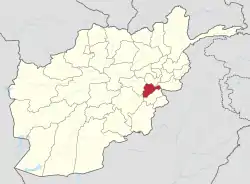Padkhwab-e Shana massacre
The Padkhwab-e Shana massacre or Pad Khwab-e Shanah massacre was a war crime perpetrated by the Red Army on 13 September 1982 in the village of Padkhwab-e Shana in the Logar Province, Afghanistan, during the Soviet–Afghan War. The people were murdered in what was described as Soviet reprisals against civilians for anti-communist resistance members and their military actions aimed against the Red Army. When a Red Army unit entered the village to search for resistance members, several villagers hid under an irrigation canal. The Russian commander told the elders to bring out all the people in the tunnel, but the elders said there is nobody there.[1] When one man emerged from the stairway, contradicting the elders, the Russian commander ordered that all the people under ground come out.[1] When the people below refused, they were killed by being burned alive in an explosion caused through a mix of gasoline, pentrite and trinitrotoluene, thrown into the canal to rout them out.[2] The people in the canal were either hiding to avoid military drafting[1] or were afraid of Soviet attacks.[3] According to the reports, 11 villagers were forced to look at the murders by the Red Army.[1]
| Padkhwab-e Shana massacre | |
|---|---|
| Part of Soviet–Afghan War | |
 Map of Afghanistan with Logar Province highlighted | |
| Location | Logar Province, Afghanistan |
| Date | 13 September 1982 |
| Target | Afghan civilians and anti-communists |
Attack type | mass murder, massacre |
| Deaths | 105 |
| Perpetrators | |
| Motive | reprisals against civilians for anti-communist resistance members |
105 people were killed in the crime, including children, old people and combatants. 61 of the victims were villagers. [4] Hundreds of Red Army soldiers stayed in the village, to look if any combatants would intervene to defend the village. Six helicopters and two jet fighters provided air support to the Red Army unit. They left the following day. It took seven days for the villagers to remove all the corpses from the canal, since the chemicals in the water would burn the feet of the people who tried to descend down the canal.[1] 2,500 armed guerrillas showed up later in the village, to prevent the Soviet army to return to it.[1] The Afghan embassy rejected the witness accounts of the massacre, claiming that the tunnels are too small for people to hide in them, though investigators contradicted them, claiming that the said tunnels are over four feet in height.[1]
See also
References
- Tyler, Patrick E. (13 February 1983). "The Horrors and Rewards of the Soviet Occupation of Afghanistan". Washington Post. Retrieved 12 September 2020.
- Bellamy 2012, p. 280.
- Ehrlich, Richard S. (14 December 1982). "Report Soviets burned 105 Afghans". UPI. Retrieved 12 September 2020.
- United Nations Commission on Human Rights 1985, pp. 30–31.
Bibliography
- Bellamy, Alex J. (2012). Massacres and Morality: Mass Atrocities in an Age of Civilian Immunity. OUP Oxford. ISBN 9780199288427.CS1 maint: ref=harv (link)
- United Nations Commission on Human Rights (1985). "Report on the situation of human rights in Afghanistan / prepared by the Special Rapporteur, Felix Ermacora, in accordance with Commission on Human Rights resolution 1984/55".CS1 maint: ref=harv (link)